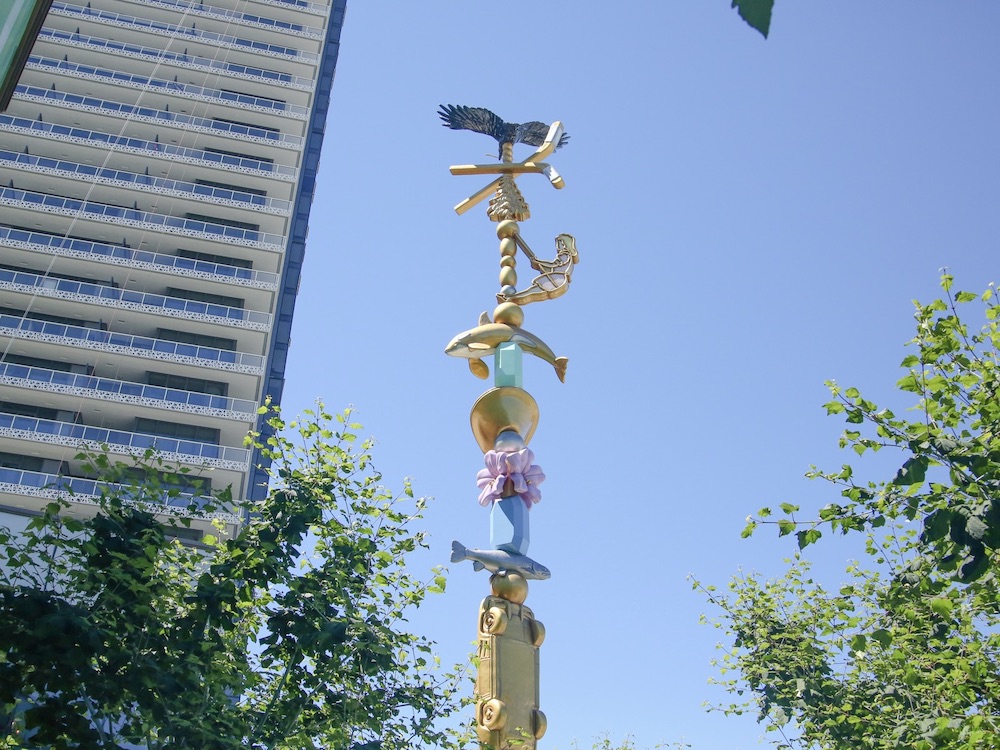A few years ago, Westbank and its founder and CEO Ian Gillespie plastered the city with bright fuchsia billboards in support of something called Fight for Beauty.
The cryptic pronouncements and ads didn’t really indicate what was at the centre of all this pink sound and fury. But even the barest look revealed that Fight for Beauty was a marketing ploy from Westbank made to look like an art exhibition.
A pre-recorded narrative accompanied the show, wherein Gillespie talked about his battles to bring different projects into existence. It was wearying barrage of self-aggrandizement and aggrievement, curdling into a screed that after a while made you want to start smashing things.
The exhibition itself was weird, consisting of scale models of real estate developments like Woodward’s and Telus Gardens. Arranged amongst these models were various cultural artifacts that Gillespie had personally accrued over the years. It was a random assortment of things: a gown from the late British fashion designer Alexander McQueen, a Fazioli piano, a Fred Herzog photograph.
But something else was at the centre of the show. A question that continues to ripple out with each new successive public art piece bought and paid for with developer’s money. Who is this art really for and who gets to decide?
Like most people, artists need money. Who has the most money at the moment? Developers. So, logically it follows that developers pay artists to make art. But like most things to do with art, money and real estate, it gets very sticky very quickly in Vancouver.
The relationship between public art and private money goes way back. But in recent years, it’s gotten even more complex.
For your rezoning, a chandelier!
Since Fight for Beauty, there have been a number of other high-profile artist/developer pairings. Rodney Graham’s Spinning Chandelier, also a Westbank collaboration, was another lightning rod for divided opinion. Weighing in at more than three tonnes and costing $4.8 million, the chandelier was installed under the Granville Bridge, where it performs a little dance twice a day for the delectation of the punters.
You can find programs in large cities like Vancouver and Richmond that seek to squeeze developers for public art, a requirement of large rezonings. That’s what happened in the case of the chandelier.
But even in cities that don’t have such a requirement, it’s common for developers to commission art for projects they’re proud of — all the better if it’s a buzz-worthy name like Graham, Douglas Coupland or Ken Lum.
While Vancouver Mayor Kennedy Stewart called Graham’s work “the most important piece of public art in the history of our city,” other folks weren’t so certain. The optics were not good, to put it mildly.
A big sparkly piece of art, with its embedded ideas of cost and privilege, in a city where housing and homelessness continues to be one of the most agonizing issues, was something of a headscratcher.
Amazing, Brentwood
All of which brings us to Douglas Coupland’s sculpture at the Amazing Brentwood mall in Burnaby. Tucked in behind the mall, beside the parking lot, close to the food court, the structure, called Charm Bracelet, isn’t highly visible at first. If you didn’t know what you were looking for, you might saunter on by without even noticing it.
In his artist’s statement, Coupland writes: “Burnaby is a mix of nature and industry and has largely been centreless until the arrival of the Amazing Brentwood. The idea of collecting themes central to Burnaby in the form of a necklace seemed like a relevant way of connecting retail culture to civic art and placemaking.”
I’m going to set aside the questionable construction of the work for a moment. If it’s supposed to be a charm bracelet composed of different images and symbols that relate to the history of Burnaby, but it mostly resembles a pastel kebab, what the hell?
Alongside generic Canadiana like hockey sticks, salmon and what kind of look like giant anal beads, one specific nod to Burnaby is the neon sign of a girl on a swing that once graced Helen’s Children’s Wear, now a landmark of the Burnaby Heights stretch of businesses on Hastings Street.
It’s the last bit in Coupland’s statement about connecting retail culture to civic art and placemaking that is the most interesting part. The idea that this mall with its amazing stores like the amazing Sephora and the amazing Suit Supply can somehow provide a cultural anchor for Burnaby seems like a slight overreach.
The conflation of art and shopping and community, flattening everything into commodifiable things that can be bought and owned, gives the most pause. The piece is owned by Shape Properties, the developer behind the Brentwood mall project.
I don’t want to pick on Coupland and imply that he is a bad person or a bad artist. Plenty of his work is ferociously insightful. His public art installations dot the city, perhaps because he’s a well-known and successful artist. More commissions beget even more, and so on. In addition to Charm Bracelet, there’s the giant pile of tires outside a Vancouver location of Canadian Tire (get it?) and the mural that coats the Berkley tower in the city’s West End (developer Reliance evicted and compensated tenants to perform a facelift that included the mural).
To employ an old phrase, don’t hate the player, hate the game. It’s easy to bang on artists for taking a commission from a developer, but everyone has to pay the rent and the bills.
To his credit, Coupland has been upfront about his motivations around commissioned pieces. On his website, he states: “Public art is like the non-fiction version of art. Instead of working in a private personal universe, public art is tethered to the real world in some way. It’s ontologically similar to writing a travel article or a historical biography. Commissioned art is also like this.”
And the real world has a lot to do with control and power: who has it and who doesn’t. Which perhaps explains the sometimes-visceral reactions that different installations or sculptures invoke in the general public.
When citizens revolt
A giant piece of poke-you-in-the-eye public art outside of a new retail or condo development is something of a flex, as the kids say. It’s as if the piece carries the voices of the people behind it: “I am putting this here, making you contend with it, because, well, I can!”
What are average citizens supposed to do if they really hate a particular piece, other than seethe? Occasionally, there’s a revolt, sometimes led by the people and other times led by artists themselves.
Many different corporations/companies have been accused of art washing, and the issue is, of course, much larger than Vancouver, as the notorious Sackler family scandal indicates.
The Sacklers, who own Purdue Pharma, were widely blamed for their role in the opioid crisis in the United States because of their approach to marketing Purdue’s opioid OxyContin. The family used part of their massive fortune to buy naming rights at major galleries around the world.
It was artists themselves who led the revolt against the company, with events like the die-in organized by photographer Nan Goldin. Other campaigns were spearheaded by artists like Ai Weiwei and Kara Walker.
Money, power and what matters to the city
In Vancouver, similar questions of money and power demand close attention. Those who pay for public art get to dictate what it will be. In which case, it’s not likely to be highly critical of the people footing the bills.
So, as a pretty bauble about a mall, perhaps Charm Bracelet is doing exactly what it’s supposed to do. So, too is Spinning Chandelier, which a few folks maintained was in fact a commentary on the deep economic divisions that have cleaved the city in two. But this argument about subversion falls a bit flat when you look at the art itself.
What is it really saying?
Tak Pham, writing for Canadian Art magazine, summed it up perfectly: “When an artwork draws inspiration from and presents content about communities affected by real-estate development and then frames such content as a celebration of history, the artists must try to maintain their integrity and criticality by making space for viewers to reflect on the complexity of gentrification.”
Some artists do this, and others don’t.
The hoary old phrase that art should “comfort the disturbed and disturb the comfortable” seems almost quaint in a city like Vancouver, where public art is often a means to put a pretty picture on the more complex realities of poverty and economic disparity.
Historically, the people who have commissioned paintings, sculptures and edifices to the glory of themselves and their empires haven’t been doing it out of the goodness of their hearts. They get something out of it, whether it’s a rezoning or a big old honking statue. But should the shaping of the culture of a place be left up to the folks with the most money, with the encouragement of our cities?
It’s an old story and also one to which there are no easy answers.
— With files from Christopher Cheung. ![]()
Read more: Art, Media, Urban Planning + Architecture
















Tyee Commenting Guidelines
Comments that violate guidelines risk being deleted, and violations may result in a temporary or permanent user ban. Maintain the spirit of good conversation to stay in the discussion.
*Please note The Tyee is not a forum for spreading misinformation about COVID-19, denying its existence or minimizing its risk to public health.
Do:
Do not: